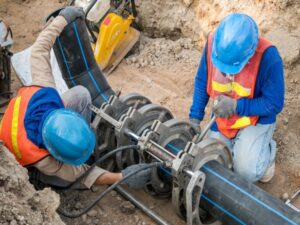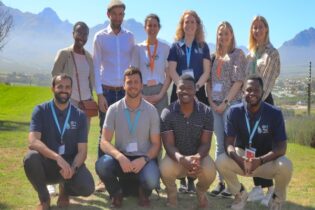Integrated water resource management (IWRM) promotes the coordinated development and management of water and land to maximise economic and social welfare, without compromising the sustainability of vital ecosystems. Here is a guideline on how water services authorities (WSAs) can implement online IWRM.
By Dr Masindi Mapholi IWRM should improve all aspects of water resource management – collecting water, storing water, distributing water, conserving water and maintaining its quality. It aims to find a balance between the social, environmental and technological perspectives of water resource management. Water service delivery is a core responsibility for districts and local municipalities, whether as a WSA or a water services provider. With IWRM, municipal officials have to adopt a holistic and integrated approach to water service delivery and water resource management. They would have to consider the health of rivers and wetlands, in addition to delivering water and sanitation to households. IWRM guidelines for local authorities The 2007 report on IWRM guidelines for local authorities requires municipal management structures to be extensively reviewed. This would be a daunting prospect for a constituency already failing to comply adequately with the Water Services Act (No. 108 of 1997) mandates. A framework has therefore been developed to provide a more consolidated guide for local government officials on how to improve water service delivery with water resource management, in line with the tasks mandated in the WSDP without undertaking immediate restructuring. By aligning the WSDP and the IWRM guidelines, and identifying tasks common to both, the framework offers municipal officials a way to incorporate IWRM tasks into water service delivery. The links between mandated WSDP and IWRM tasks are strong. Solid waste management and stormwater management are already mandated municipal management responsibilities. Practicing IWRM as a service provider, therefore, requires some realignment of institutional structures and the adding of a few important new responsibilities to already existing directorates. Elements of the WSDP The WSDP consists of 10 elements: 1. Socio-economic profile – municipal demographics with income and employment patterns, and the status of health service, sanitation and waterborne diseases. 2. Service level profile – an overview of water and sanitation services in place, as well as any plans for improvement. 3. Water resource profile – quality and quantity of water available to the municipality (both surface water and groundwater). 4. Water conservation and demand management – quantities must be known, with programmes required to set targets for the use and conservation of water. Conservation includes education of consumers, keeping track of leaks, metering water use, and control of alien vegetation. 5. Water service infrastructure – assessment, maintenance and management of water and sanitation infrastructure, including water storage structures such as reservoirs and dams, an evaluation of the water service assets, as well as staff expertise.6. Water balance – quantities of bulk water, including volumes treated for consumers, and volumes entering and being released as effluent from water treatment works.
7. Institutional arrangements – the laws and regulations that govern the management and allocation of water must be understood. 8. Consumer user profile – are people receiving the service to which they are entitled? People education, protective by-laws, and opportunities for consumer complaints are required. 9. Financial profile – the financing of the different water-related services. 10. List of projects – lists of projects currently under way or planned in the future, and the means by which their development can be tracked. Implementing a WSDP through IWRM After a WSDP has been completed and implemented, the development and implementation of an IWRM plan is possible. At present, the completion of the WSDP is generally outsourced to consultants. It should be an in-house planning process that is divided into five phases that should be implemented over two years. For greater detail on the five phases, as well as a step-by-step process within each phase, please contact MapholiM@dws.gov.za. Phase 2 – water quality assessment: Monitor the performance of WSA responsibilities and the compliance with water-use permits (DWS staff should assist). The water-use permits will vary according to the businesses and industries present in the regional municipal area. By-laws to regulate water service and wastewater discharge must be developed, promulgated and adopted. By achieving this, the WSA will gain improved public credibility for municipal management with improved levels of payment for service. There will be an efficient and dependable monitoring system for municipal functionality. Phase 3 – operational maintenance and rehabilitation strategies: Sustainable management practices ensure the maintenance of a healthy environment by providing quality potable water, and cleaner rivers and wetlands (water resources); they also extend the life of infrastructure. Improvement in the management of wastewater treatment plants results in better quality of water resources and minimises waterborne diseases. The performance management system will also be refined. Once all management plans have been successfully implemented, capital projects such as major extension and refurbishment of overextended infrastructure can be properly budgeted. Phase 4 – monitoring and review of services: Undertake strategic gap assessments and lay the groundwork for the development of implementation strategies to bridge these gaps. These tasks form the basis of a sound service delivery strategy and should be reviewed annually to highlight gaps in service delivery. All municipalities should be managed according to agreed-on performance criteria stabilising the Service Delivery Business Implementation Plan. Risk assessment could be an outcome of the review process. The Department of Water and Sanitation has developed several guidelines for environmental best practice monitoring and auditing, accessible from http://ws.dwa.gov.za/wsdp/UserRegistration.aspx. Phase 5 – implementation strategies for WSDP: An ‘integration forum’ must be appointed. The benefits of the proposed substantial changes in management must be clearly understood, well put forward, and possible conflicts pre-empted by careful planning and exploring of all possible potential problem areas. Integrated development plan The Municipal Systems Act (No. 32 of 2000) states that an Integrated Development Plan (IDP) must be prepared to ensure proper coordination and integration of development. IDPs are the most important mechanism available to the government to transform structural differences in South Africa’s previously divided society. The IDP process is also one of the primary means of developing a community through the promotion of public participation in its analyses and planning phases. However, the IDP does not require that water availability and demand be considered during all parts of development planning, and neither does the IDP process require a discussion of how development will impact natural resources. In addition, the IDP deals separately with those services that impact water resources such as solid waste management, stormwater management, and water service and sanitation. This is not conducive to IWRM.






